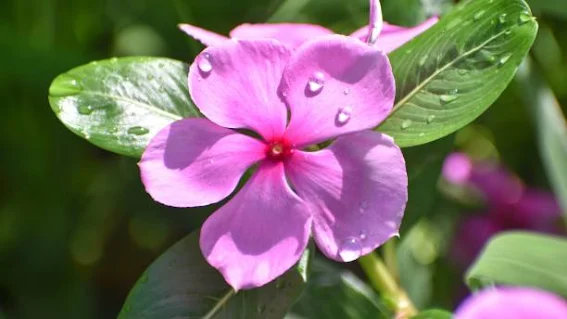The Evergreen Plant (Catharanthus roseus):
A Pillar of Medicinal Science
The perennial plant Catharanthus roseus, often known as "Periwinkle," serves as a prime example in the field of medicinal.Originally native to Madagascar, this species has achieved global acclaim for its extensive therapeutic applications. Its prominence spans both cutting-edge pharmaceutical research and the traditions of Ayurvedic medicine, owing to its diverse and potent biochemical repertoire.
Distinctive Bioactive Compounds
A defining feature of Catharanthus roseus is its production of vinca alkaloids, a sophisticated class of compounds instrumental in managing diseases like cancer and diabetes. Additionally, the plant's pronounced anti-inflammatory, antioxidant, and antimicrobial properties underscore its multifaceted medicinal potential.
Glycemic Regulation and Diabetes Management
The plant’s leaves and flowers are replete with bioactive constituents exhibiting potent anti-diabetic properties. These compounds improve insulin sensitivity and regulate blood glucose levels. Extensive research validates their role in optimizing glucose metabolism and alleviating complications associated with diabetes.
Anti-Cancer Potency
The vinca alkaloids vinblastine and vincristine are globally recognized for their chemotherapeutic applications. These alkaloids disrupt mitotic processes, effectively inhibiting the proliferation of cancer cells. Their inclusion in treatment protocols for leukemia and lymphoma underscores their clinical significance.
Neuroprotective Effects in Diabetic Neuropathy
By leveraging its anti-inflammatory properties, Catharanthus roseus alleviates nerve damage and neuropathic pain prevalent in diabetes. Its potential to mitigate inflammation and enhance neuronal health reinforces its therapeutic relevance.
Cardiovascular Benefits
Rich in antioxidants, the plant contributes substantially to cardiovascular health. Its bioactive compounds regulate blood pressure, mitigate oxidative stress, and support cardiac function, thereby reducing the prevalence of heart diseases.
Dermatological Applications
For centuries, the leaves of Catharanthus roseus have been utilized in treating a range of skin conditions, such as fungal infections and eczema. Its antiseptic properties protect against infections and accelerate wound healing, establishing its value in dermatological care.
Antimicrobial and Regenerative Properties
The plant’s extracts exhibit robust antimicrobial activity, preventing infections and fostering tissue regeneration. These characteristics render it a natural and reliable antiseptic.
Pharmacological Contributions
Beyond vinca alkaloids, compounds like vincamine and serpentine enhance the plant’s pharmacological utility. These metabolites are pivotal in the formulation of drugs addressing various systemic diseases.
Detoxification and Blood Purification
Juice extracted from Catharanthus roseus leaves exhibits detoxifying properties, promoting the elimination of toxins and purification of blood. These actions complement the plant’s broader health benefits.
Preparations for Health Enhancement
Infusions and juices derived from the plant’s leaves serve as functional beverages. These preparations improve glycemic control and bolster the immune system, further cementing the plant’s role in preventive health care.
Ease of Cultivation and Accessibility
The adaptability and low-maintenance nature of Catharanthus roseus make it widely available, especially in India. Its dual role as a decorative and medicinal plant enhances its practicality and appeal.
Empirical Validation and Research
Scientific investigations, both clinical and preclinical, have substantiated the medicinal properties of Catharanthus roseus. Its efficacy in regulating glycemic levels, combating cancer, and addressing inflammatory disorders reinforces its standing as a cornerstone of integrative medicine.
Safety and Precautionary Measures
- 1. Professional Consultation: Always seek medical advice before therapeutic use.
- 2. Controlled Dosage: Overconsumption can cause gastrointestinal disturbances and other adverse effects.
- 3. Pregnancy and Lactation: Avoid use without medical supervision during pregnancy or nursing.
- 4. Allergic Reactions: Conduct allergy testing to ensure safe application.
Alternative Applications
- ·
Medicinal Powder: Dried leaves can be ground into a powder for versatile use.
- ·
Health Tonic: Fresh juice consumed on an empty stomach revitalizes energy and
enhances systemic health.
- ·
Horticultural Value: The plant’s ornamental appeal complements its medicinal virtues,
making it a valuable addition to gardens.
Conclusion
The unique phytochemical profile of Catharanthus roseus elevates it to a critical position in addressing complex health challenges, including metabolic disorders, malignancies, and dermatological conditions. Its integration into therapeutic frameworks embodies a sustainable and holistic approach to health care. Adherence to safety guidelines and professional oversight is essential to unlocking its full therapeutic potential while mitigating risks. This plant epitomizes the intersection of traditional medicinal knowledge and modern scientific innovation.














0 Comments